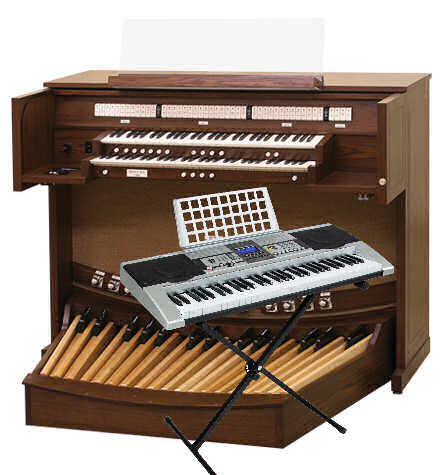A KEYBOARD OR AN ORGAN?

What is preferable? A keyboard or an organ? Is a keyboard just a small organ? What many people don't realise is just how versatile organs have become and the advantages they might have over keyboards.
Keyboards consist of one single keyboard. Some have weighted keys, and others do not. Weighted keys feel like a piano to play whereas non weighted keys feel more like an organ to play. Depending on whether you prefer the feel of a piano or the feel of an organ will determine if you prefer weighted keys or not. Keyboards are usually "velocity sensitive" which means the faster a note is played, the louder it sounds. An organ will have at least two keyboards, sometimes three or four, as well as a pedalboard which is played with the feet. Traditional organ keyboards were not velocity sensitive, but modern organ keyboards generally are. Traditional organ sounds will not respond to changes in note velocity, but orchestral and synthesised sounds do.
A keyboard is designed to be light and portable, and can easily be taken from venue to venue. An organ is large and heavy, and moving it is more difficult.
A keyboard does not usually have any sound system. It may have a couple of small speakers which are just sufficient for using the instrument in a small room but many keyboards do not even have that. They rely on being connected to a larger audio system to function. Organs have their own audio system, usually a minimum of two (and often many more) audio channels with multiple speaker systems to provide the volume and frequency response required. Often, the audio of a keyboard and other instruments is fed into an organ's audio system - the organ's audio system is designed to accurately reproduce music, unlike a PA system which is designed to just amplify voices.
Both keyboards and organs appear complex to operate. The many different manufacturers of keyboard each have their own methods for choosing voices, altering sounds and displaying which voices have been selected. It is often difficult to work out how to use anything other than the basic functions, without having to refer to the operator's manual. An organ has rows of stop tabs, which are often engraved with the names of the stops based on unfamiliar terminology. However, it is easy and intuitive to turn stops on or off to add to the sound or change the sound.
A keyboard has just the one manual, which makes it challenging to play different sounds with each hand. To achieve this, keyboards have the functionality of being able to split a manual into two halves, and different sounds can be assigned to the two halves. An organ has multiple manuals, which allows the musician to set up different sounds on each manual, and then swap between manuals to quickly change sounds, or to play the melody on one manual and the accompaniment on another manual.
Keyboards can produce a variety of sounds, whereas traditionally, organs could only sound like a pipe organ. However, this has changed, and with an expander (or even a keyboard) connected to an organ using MIDI, an organ can now produce the same variety of sounds that a keyboard can produce. Actually, an organ is more flexible because of the way sounds can be coupled between manuals. The melody coupler on an Allen organ can be used to accent just the upper note of a chord. The bass coupler will do the same for the bottom note of the chord. GeniSys voices on an Allen organ can be coupled independently of the standard organ voices, allowing even more versatility in producing tonal colour. And mapping a MIDI voice to just a portion of a keyboard provides even more variety.
Ultimately, the choice between a keyboard or an organ depends on all of the above factors, as well as budget. But one thing is for certain - the organ of today is so much more versatile than its predecessors and capable of producing truly amazing music.
![]()

